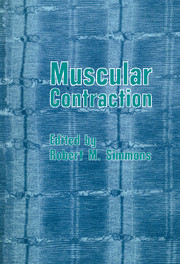Book contents
- Frontmatter
- Contents
- Dedication
- Contributors
- Preface
- 1 A. F. Huxley: an essay on his personality and his work on nerve physiology
- 2 A. F. Huxley's research on muscle
- 3 Ultraslow, slow, intermediate, and fast inactivation of human sodium channels
- 4 The structure of the triad: local stimulation experiments then and now
- 5 The calcium-induced calcium release mechanism in skeletal muscle and its modification by drugs
- 6 Hypodynamic tension changes in the frog heart
- 7 Regulation of contractile proteins in heart muscle
- 8 Differential activation of myofibrils during fatigue in twitch skeletal muscle fibres of the frog
- 9 High-speed digital imaging microscopy of isolated muscle cells
- 10 Inotropic mechanism of myocardium
- 11 Regulation of muscle contraction: dual role of calcium and cross-bridges.
- 12 Fibre types in Xenopus muscle and their functional properties.
- 13 An electron microscopist's role in experiments on isolated muscle fibres.
- 14 Structural changes accompanying mechanical events in muscle contraction.
- 15 Mechano-chemistry of negatively strained cross-bridges in skeletal muscle.
- 16 Force response in steady lengthening of active single muscle fibres.
- References
- Index
11 - Regulation of muscle contraction: dual role of calcium and cross-bridges.
Published online by Cambridge University Press: 07 September 2010
- Frontmatter
- Contents
- Dedication
- Contributors
- Preface
- 1 A. F. Huxley: an essay on his personality and his work on nerve physiology
- 2 A. F. Huxley's research on muscle
- 3 Ultraslow, slow, intermediate, and fast inactivation of human sodium channels
- 4 The structure of the triad: local stimulation experiments then and now
- 5 The calcium-induced calcium release mechanism in skeletal muscle and its modification by drugs
- 6 Hypodynamic tension changes in the frog heart
- 7 Regulation of contractile proteins in heart muscle
- 8 Differential activation of myofibrils during fatigue in twitch skeletal muscle fibres of the frog
- 9 High-speed digital imaging microscopy of isolated muscle cells
- 10 Inotropic mechanism of myocardium
- 11 Regulation of muscle contraction: dual role of calcium and cross-bridges.
- 12 Fibre types in Xenopus muscle and their functional properties.
- 13 An electron microscopist's role in experiments on isolated muscle fibres.
- 14 Structural changes accompanying mechanical events in muscle contraction.
- 15 Mechano-chemistry of negatively strained cross-bridges in skeletal muscle.
- 16 Force response in steady lengthening of active single muscle fibres.
- References
- Index
Summary
Introduction
I began work with Andrew Huxley in December 1960, immediately after getting my Ph.D. in solid state physics from Cornell University and just after he had taken the chair in Physiology at University College, London. Professor Huxley, the physiologist, felt that I should be well trained in this field so I took the part 2 program in Physiology while beginning my research. I am grateful for this training as I teach medical and graduate students while pursuing my research.
My initial study investigated the question raised in his paper with Rolf Niedergerke (A.F. Huxley & Niedergerke, 1958) entitled “Measurements of the striations of isolated muscle fibres with the interference microscope.” Under some conditions, they had observed apparent shortening of both I- and A-bands particularly at high degrees of shortening. We reinvestigated this question using local stimulation and the interference microscope that Professor Huxley had designed and built, and found that the A-band shortening occurred only in sarcomeres that were shortening passively, being pushed by neighbouring sarcomeres that were shortening actively. In the actively shortening sarcomeres, no Aband shortening was observed, but formation of contraction bands at sarcomere lengths consistent with the sliding-filament theory was noted (A.F. Huxley & Gordon, 1962). This study showed me his dedication to finding out the truth, and not letting apparent anomalous behaviour go unexplained.
After these studies, we began to design and construct an apparatus for controlling sarcomere length to revisit the length-tension relationship. We were motivated by his observations (A.F. Huxley & Peachey, 1961) that sarcomere lengths were not uniform along the length of a single muscle fibre.
- Type
- Chapter
- Information
- Muscular Contraction , pp. 163 - 180Publisher: Cambridge University PressPrint publication year: 1992
- 4
- Cited by



